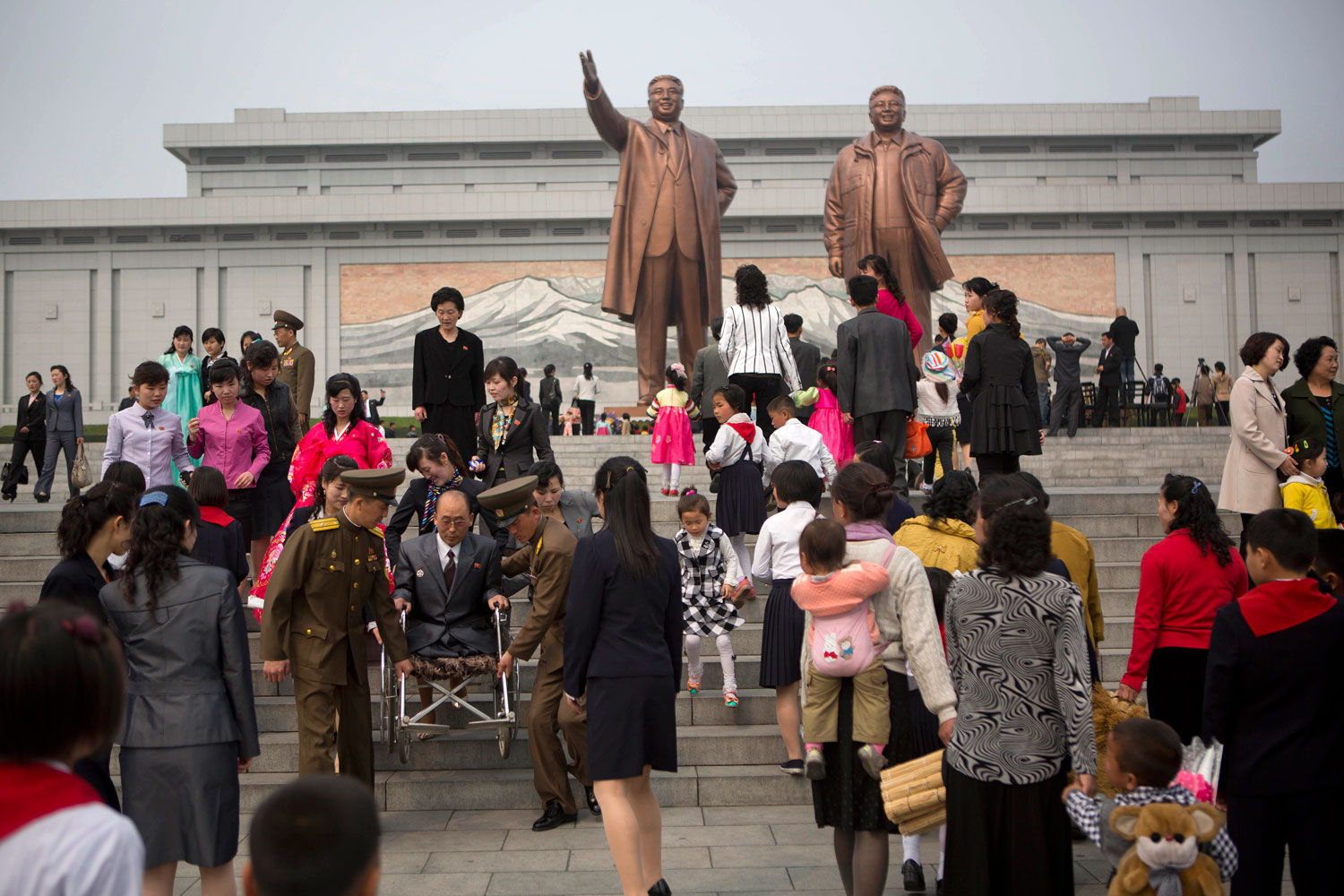
It is party time in Pyongyang. Tuesday marks the 102nd anniversary of the birth of North Korea’s founding father, Kim Il Sung. It is one of the most important days of the year, so much so that, in 1997, the country replaced the Gregorian calendar with one that begins with the Great Sun’s birth, on April 15, 1912. And though the festivities tend to follow a familiar script — parades, florid speeches, a flower festival — the holiday usually holds some clues as to what is going on inside the Democratic People’s Republic of Korea, as it is officially called.
The annual Day of the Sun celebrations are typically used to champion the Kim family and its “military first” message. In 2012, Kim Jong Un marked the occasion with a (failed) rocket launch and a military parade. Last year’s anniversary capped months of warmongering rhetoric. Since then, North Korea’s defiant stance seemed to soften slightly, then harden once again: after a successful round of family reunions in February, North Korea spent the past month expressing, in wildly sexist terms, its displeasure with South Korean President Park Geun-hye, firing shells near a disputed maritime border, then promising a “new kind” of nuclear test.
This year, dictator Kim Jong Un skipped the military parade and the crowds that come with it. State media reported he paid a midnight visit to the capital’s Kumsusan Palace of the Sun, the mausoleum where his grandfather’s embalmed body rests. In an address to mark the holiday, the country’s nominal head of state, Kim Yong Nam, urged loyalty. “Being loyal to Comrade Kim Jong Un’s leadership is the decisive guarantee to carry forward with the Great Comrade Kim Il Sung and Kim Jong Il’s thoughts and accomplishments,” he said, according to state media.
For Kim Jong Un, Day of the Sun events are part of a broader effort to tie his life and leadership to that of his grandfather, birthday boy Kim Il Sung. It is difficult to overstate Kim the First’s influence: in North Korea, he is worshipped like a god. His words are parsed, his portrait revered. As Korea scholar Andrei Lankov details in his book North of the DMZ, the Great Leader is everywhere, including primary-school math texts: “The Great Leader–Father Kim Il Sung was, as a child, once given nine apples. He gave three to his grandfather, two to his grandmother, one to his father and one to his mother,” reads a sample prompt. “How many apples did he give away and how many did he keep for himself?”
North Koreans are taught that he was an exceptional warrior who, while camping at the base of Mount Paektu with a small group of comrades, crushed the Japanese colonialists. He then went on to repel the imperialist Americans during the 1950–53 Korean War. According to official history, his heir, Kim Jong Il, was born at the base of the same scared mountain, and he inherited his father’s otherworldly prowess. The message, says Yang Moo-jin, a professor at Seoul’s University of North Korean Studies, is that “the Paektu bloodline is the only bloodline entitled to lead the country and to carry on the revolution.”
What’s interesting is that Kim Jong Un seems to be channeling his grandfather more than his dad. This makes sense. Many older North Koreans look back fondly on the Kim Il Sung era, a time of relative prosperity before the collapse of the Soviet Union and the famine of the 1990s. Even critics find it tough to speak ill of the Great Sun. “If you ask defectors [to South Korea] if they still revere Kim Il Sung, the absolute majority, maybe 90%, still say yes,” says Cheong Seong-chang, a senior fellow at the Sejong Institute in Seoul.
Kim Jong Un both acts and looks like his granddad. Unlike Kim Jong Il, who was somewhat reclusive, Kim Jong Un has cultivated a more approachable, Kim Il Sung–esque image. Photographs from his official tours show people touching his arms, even embracing the young despot — acts that would have been unthinkable during his father’s time, according to Park Hyeong-jung, a senior research fellow at the Korea Institute for Unification, a Seoul-based think tank. “The whole image, from the style of haircut to the amount of fat on his face, was calculated,” says Park. “I suspect he gained weight to look like his grandfather, that he spent many hours trying to act like him.”
Acting like grandpa also means keeping the country on the lookout for would-be aggressors and perpetually bracing for war. Although the morning of April 15 came and went without incident, many North Korea watchers wonder if there will soon be another symbolic show of force, perhaps to protest ongoing U.S.–South Korea military exercises. As to what, when and where — well, the Kim men like to keep us guessing.
— With reporting by Stephen Kim / Seoul
More Must-Reads from TIME
- Donald Trump Is TIME's 2024 Person of the Year
- Why We Chose Trump as Person of the Year
- Is Intermittent Fasting Good or Bad for You?
- The 100 Must-Read Books of 2024
- The 20 Best Christmas TV Episodes
- Column: If Optimism Feels Ridiculous Now, Try Hope
- The Future of Climate Action Is Trade Policy
- Merle Bombardieri Is Helping People Make the Baby Decision
Write to Emily Rauhala / Beijing at emily_rauhala@timeasia.com